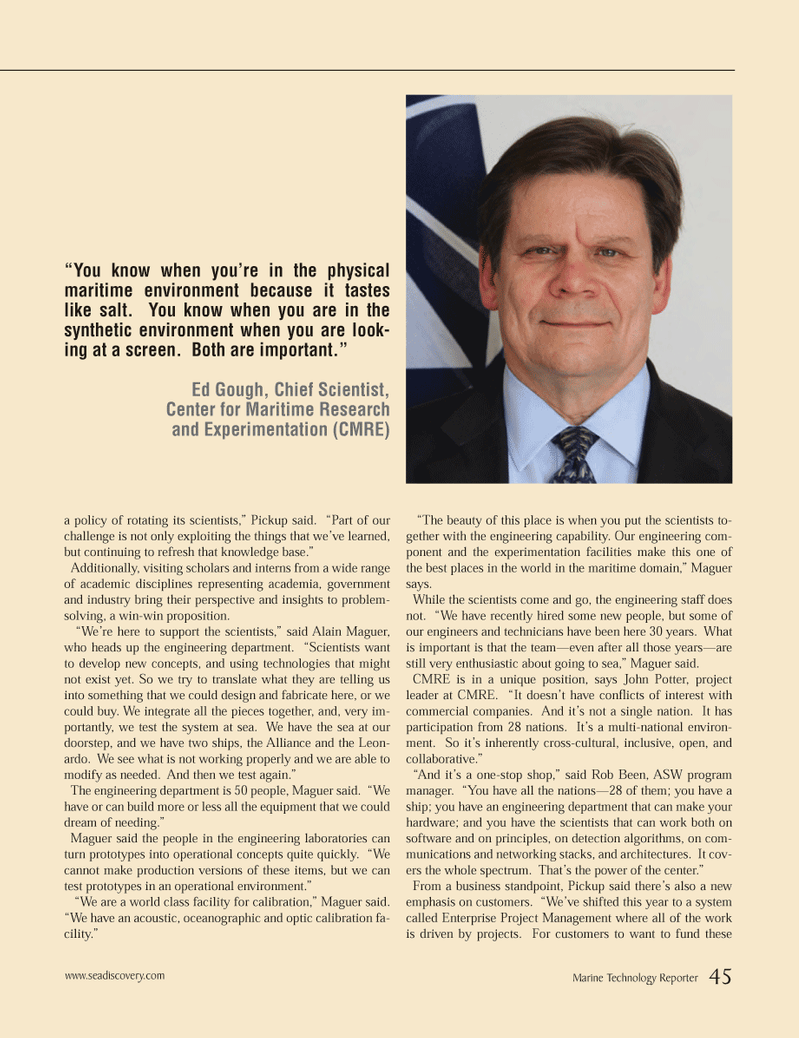
Page 45: of Marine Technology Magazine (November 2012)
Fresh Water Monitoring & Sensors
Read this page in Pdf, Flash or Html5 edition of November 2012 Marine Technology Magazine
a policy of rotating its scientists,? Pickup said. ?Part of our challenge is not only exploiting the things that we?ve learned, but continuing to refresh that knowledge base.? Additionally, visiting scholars and interns from a wide range of academic disciplines representing academia, government and industry bring their perspective and insights to problem- solving, a win-win proposition. ?We?re here to support the scientists,? said Alain Maguer, who heads up the engineering department. ?Scientists want to develop new concepts, and using technologies that might not exist yet. So we try to translate what they are telling us into something that we could design and fabricate here, or we could buy. We integrate all the pieces together, and, very im- portantly, we test the system at sea. We have the sea at our doorstep, and we have two ships, the Alliance and the Leon- ardo. We see what is not working properly and we are able to modify as needed. And then we test again.? The engineering department is 50 people, Maguer said. ?We have or can build more or less all the equipment that we could dream of needing.? Maguer said the people in the engineering laboratories can turn prototypes into operational concepts quite quickly. ?We cannot make production versions of these items, but we can test prototypes in an operational environment.? ?We are a world class facility for calibration,? Maguer said. ?We have an acoustic, oceanographic and optic calibration fa- cility.? ?The beauty of this place is when you put the scientists to-gether with the engineering capability. Our engineering com- ponent and the experimentation facilities make this one of the best places in the world in the maritime domain,? Maguer says. While the scientists come and go, the engineering staff does not. ?We have recently hired some new people, but some of our engineers and technicians have been here 30 years. What is important is that the team?even after all those years?are still very enthusiastic about going to sea,? Maguer said. CMRE is in a unique position, says John Potter, project leader at CMRE. ?It doesn?t have con icts of interest with commercial companies. And it?s not a single nation. It has participation from 28 nations. It?s a multi-national environ- ment. So it?s inherently cross-cultural, inclusive, open, and collaborative.? ?And it?s a one-stop shop,? said Rob Been, ASW program manager. ?You have all the nations?28 of them; you have a ship; you have an engineering department that can make your hardware; and you have the scientists that can work both on software and on principles, on detection algorithms, on com- munications and networking stacks, and architectures. It cov- ers the whole spectrum. That?s the power of the center.? From a business standpoint, Pickup said there?s also a new emphasis on customers. ?We?ve shifted this year to a system called Enterprise Project Management where all of the work is driven by projects. For customers to want to fund these ?You know when you?re in the physical maritime environment because it tastes like salt. You know when you are in the synthetic environment when you are look-ing at a screen. Both are important.?Ed Gough, Chief Scientist, Center for Maritime Research and Experimentation (CMRE)Marine Technology Reporter 45 www.seadiscovery.com MTR #9 (34-49).indd 45MTR #9 (34-49).indd 4512/3/2012 11:33:50 AM12/3/2012 11:33:50 AM

 44
44

 46
46
